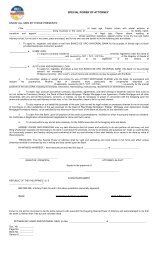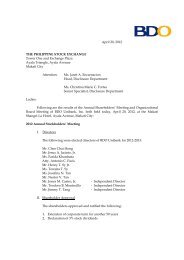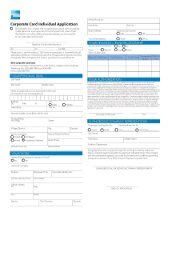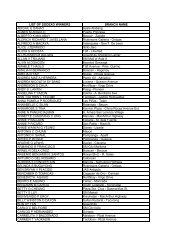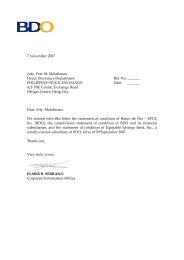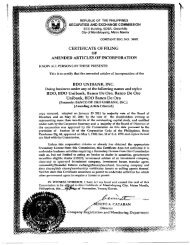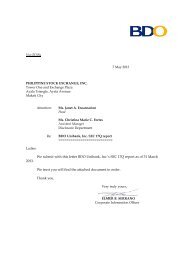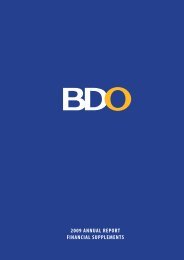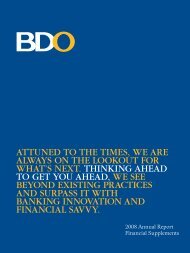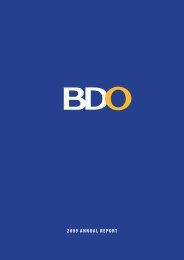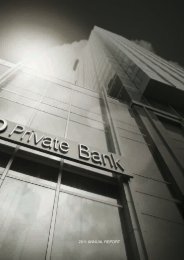2010 BDO Annual Report
2010 BDO Annual Report
2010 BDO Annual Report
You also want an ePaper? Increase the reach of your titles
YUMPU automatically turns print PDFs into web optimized ePapers that Google loves.
We find ways<br />
Review of <strong>2010</strong> Operations<br />
Economic Environment<br />
Posting Gains on Solid<br />
Fundamentals<br />
The Philippine economy recorded its best performance in over three decades with a<br />
7.3% growth in gross domestic product (GDP) in <strong>2010</strong>, surpassing the government’s<br />
initial target of 5% to 6%.<br />
This growth was bolstered by:<br />
<br />
<br />
<br />
Market pundits said the strong<br />
fundamentals of the Philippine economy<br />
allowed it to expand and triumph over<br />
a challenging external environment<br />
caused by a weak US recovery, lingering<br />
European sovereign debt crisis, rising<br />
global inflation pressures, as well as<br />
capital influx from the impact of US<br />
Quantitative Easing (QE2), a monetary<br />
policy used by some Central Banks to<br />
stimulate the economy.<br />
Consumption spending in <strong>2010</strong><br />
rose 5.3 % on the back of low inflation<br />
and interest rates, as well as higher<br />
remittances from the Overseas Filipino<br />
Workers (OFW) and steady revenues<br />
from the Business Process Outsourcing<br />
(BPO) sector. And with the renewed<br />
investors’ confidence following the<br />
election of Benigno “Noynoy” C.<br />
Aquino III as the 15th President of the<br />
Philippines, fixed investments increased<br />
17% channeled largely to construction<br />
and durable goods to meet growing<br />
demand.<br />
Election spending created demand<br />
for campaign-related goods and<br />
services, generating seasonal jobs and<br />
extra incomes. Government spending<br />
was frontloaded in the first half of the<br />
year to rebuild the areas damaged by<br />
typhoons Ondoy (“Ketsana”) and Pepeng<br />
8<br />
(“Parma”) that hit the country in late 2009.<br />
Meanwhile, exports grew 26% in <strong>2010</strong><br />
on inventory restocking and increased<br />
external demand following the global<br />
downturn in 2009.<br />
The broad-based demand showed in<br />
the favorable performance in industry<br />
and services. Among the industry<br />
sectors, manufacturing and mining were<br />
clear winners with annual growth rates<br />
of 12.3% and 18.4%, respectively, as these<br />
benefited from the big export rebound<br />
and favorable global prices. Meanwhile,<br />
services grew by 7.1%, led by real estate,<br />
trade, and private services. Only the farm<br />
sector posted a decline due to the impact<br />
of the El Nino.<br />
INFLATION<br />
Gross Domestic Product<br />
1.1%<br />
2009<br />
7.3%<br />
<strong>2010</strong><br />
From a high of 4.4% in April and May,<br />
the headline inflation rate settled at 3%<br />
in November and December on stable<br />
food prices, electricity rate cuts, and price<br />
rollbacks for socially sensitive products<br />
kerosene and liquefied petroleum gas<br />
or LPG. The peso appreciation also<br />
tempered the impact of imported inflation<br />
notwithstanding rising global commodity<br />
price pressures. The average inflation rate<br />
was 3.8% for <strong>2010</strong> versus 3.2% in 2009,<br />
falling near the low end of the Bangko<br />
Sentral’s 3.5%-5.5% inflation target.<br />
FOREIGN EXCHANGE<br />
The peso strengthened to P43.88/US$1<br />
by year-end <strong>2010</strong> from the P46.36/US$1<br />
end-of-period rate in 2009; while the<br />
average foreign exchange rate rose 5.6%<br />
to P45.11/US$1 in <strong>2010</strong> from P47.64/US$1<br />
in 2009.<br />
The peso’s strong performance was<br />
boosted by the strong OFW remittances<br />
(+8.2% year-on-year to US$18.8 billion);<br />
higher BPO incomes (US$9.0 billion);<br />
and increased export earnings (US$51.4<br />
billion in <strong>2010</strong> vs. US$38.4 billion in 2009).<br />
Further adding to dollar liquidity was<br />
the surge in portfolio investments to<br />
US$4.6 billion in <strong>2010</strong> from just US$388<br />
million the previous year. Foreign capital<br />
had shifted to emerging markets like the<br />
Philippines that offered higher yields<br />
compared to the near-zero interest<br />
rate in the US following the US Fed’s



